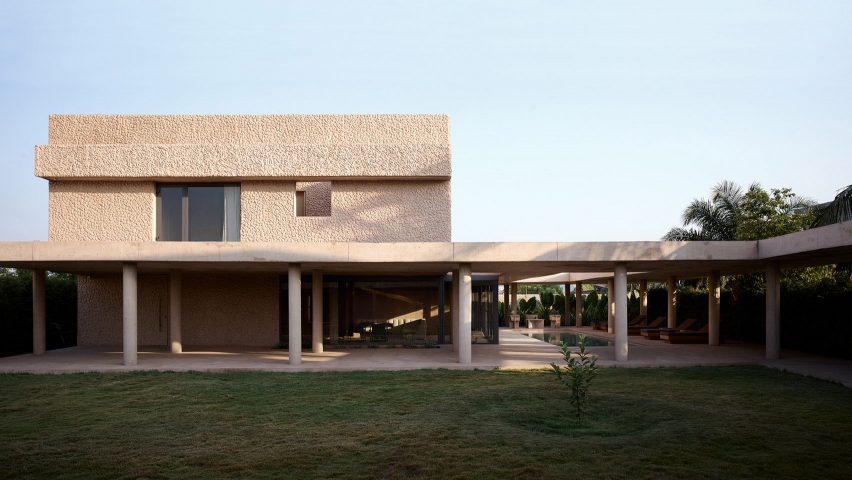Architecture studio DeRoché Strohmayer has converted a deteriorating two-storey house on the outskirts of Accra, Ghana, into a retreat for artist and writer residencies.
Named Dot.ateliers Ogbojo, the retreat combines living areas and workspaces at the edge of the city that offer access to nature and aim to encourage creativity.
The former two-storey home has been transformed by DeRoché Strohmayer with brighter interiors, alongside a new canopy, outside spaces and an open ground-floor facade.
"Designed to be a place of respite and regeneration, Dot.ateliers Ogbojo is an adaptive reuse project, characterised by courtyards and voids on all scales, creating spaces of calm and varying levels of privacy within an otherwise heterogeneous, dynamic urban context," studio co-director Glenn DeRoché told Dezeen.
"The existing building was a typical two-story family house, not older than ten years but already deteriorating rapidly due to inadequate design and construction methods," added co-director Juergen Strohmayer.
"Our initial steps were subtractive: we removed the central parking lot and replaced it with a garden, we refocused the massing around the courtyard and other pockets of green, and we opened the ground floor facade to connect with this new landscape."
Inside, Dot.ateliers Ogbojo contains a mix of living spaces and informal collaborative workspaces for artists undertaking residencies on the site.
The site's communal spaces, including living areas, a library, a gym and a kitchen, occupy the ground floor while the residential area, comprising private ensuite rooms, is located upstairs.
Alongside the existing volume, the site has been updated with gardens and a canopy that wraps around a central courtyard and covers an outdoor living space.
"This creative hub, initiated by the artist Amoako Boafo, is meant to be a place for invited intellectuals and artists to share a place to live, ponder and rest over the course of several months," said the studio.
The existing building was previously dark and humid inside, so the interior has been brightened with a series of voids, including lightwells and smaller openings that bring in light and air.
Some of the voids double as outdoor living spaces where the studio hopes that artists at Dot.ateliers Ogbojo can meet, dine, and relax.
Floor-to-ceiling windows set within a black frame border a large portion of the ground floor, forming a new ground-floor facade added by the studio to reconnect the building to the landscape.
"The interiors were dark and humid," said DeRoché. "The compound was almost fully paved and lacked vegetation or shade to make for comfortable exterior spaces."
"Each room on the ground floor is framed by an external view – a picture window – of the many themed landscapes that surround the main building, allowing for continual connection to nature as one moves from the exterior to the interior," continued the studio.
"The building not only frames views to the gardens but also to the sky through a series of light shafts that permeate the building interiors and exteriors at various locations and depths, allowing for an abundance of light without any direct heat gain," said the studio.
Inside, textured plaster and other rough finishes feature across the ceiling, floors, and walls, giving an earthy feel that is complemented by pale furnishings and wooden joinery.
Completing the project, the concrete canopy outside wraps around the central courtyard, supported by roughly textured columns. It covers a walkway that encloses a swimming pool and doubles as a lounge area, dotted with sun beds and seating areas.
Other artist retreats on Dezeen include a stilted structure in Mumbai by Architecture Brio and an off-grid pavilion on the coast of Inis Oírr island by Jordan Ralph.
The photography is by Julien Lanoo.

